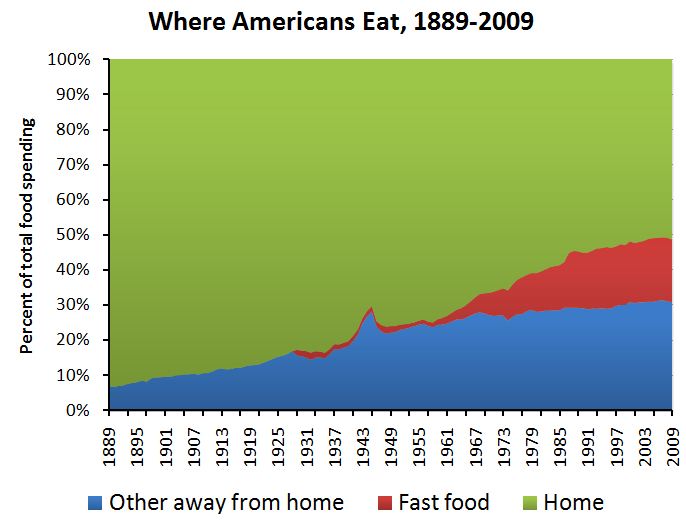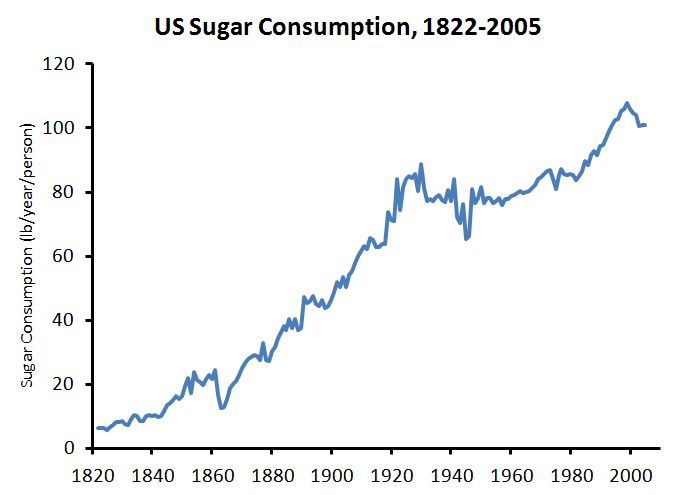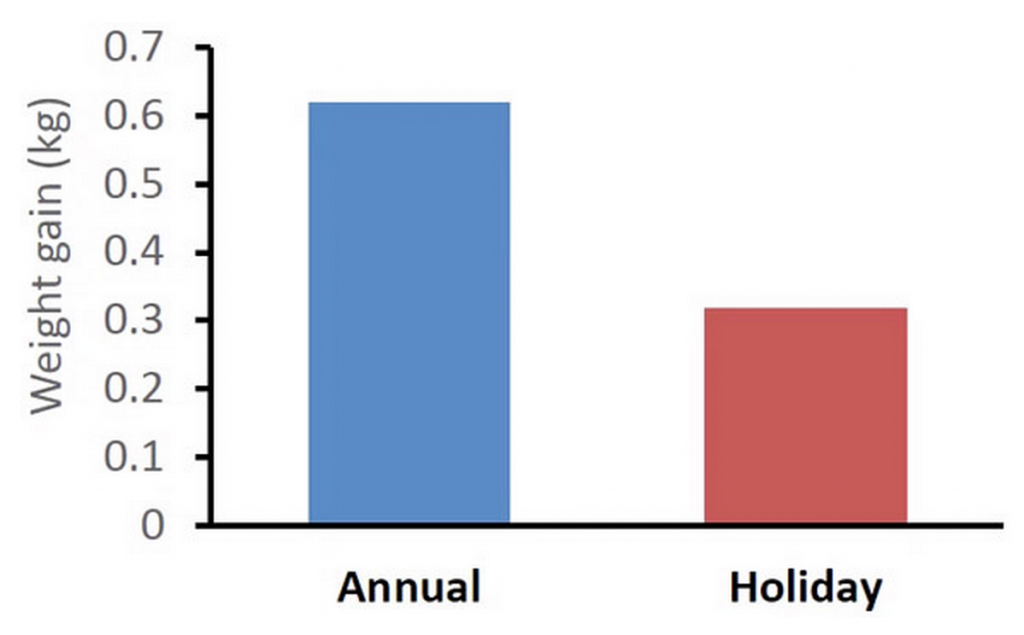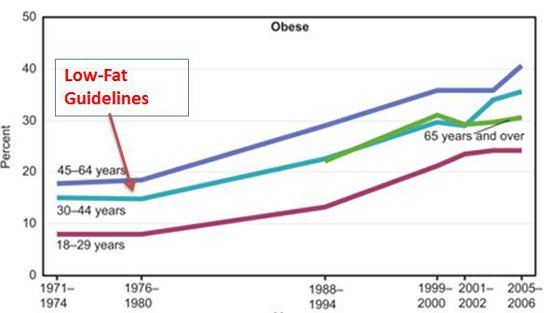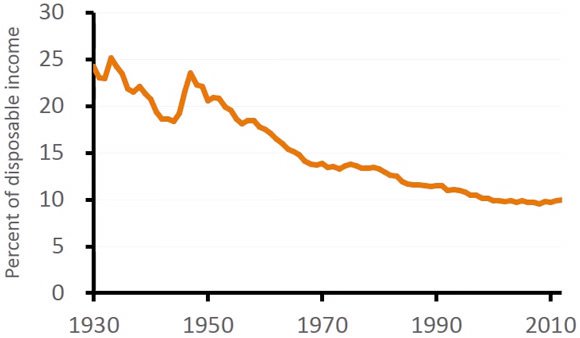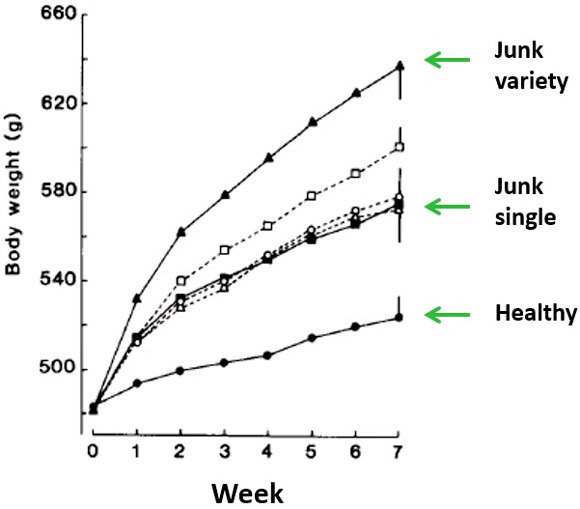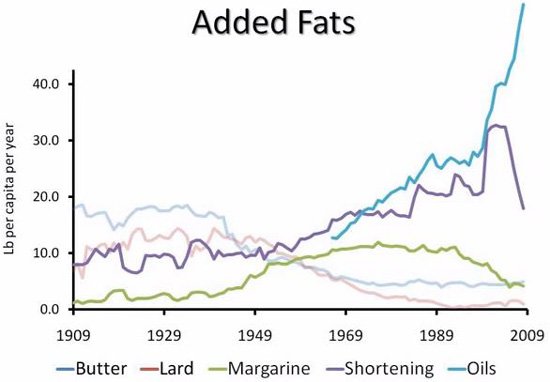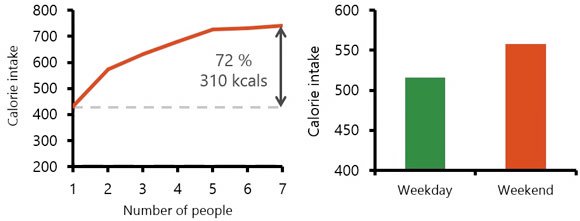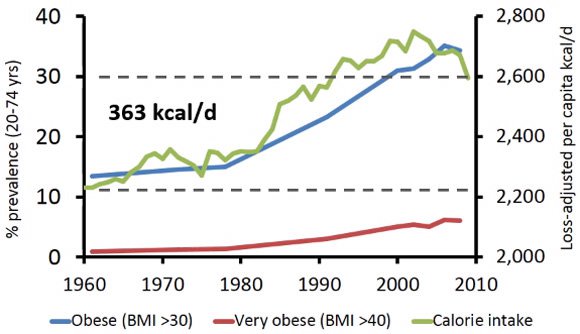In the last few decades there has been a dangerous rise of obesity among Americans. Here’s how it happened.
Since the early 1980s, we’ve been battling an “obesity epidemic.” Obesity rates have tripled and doctors are finding obesity at the root (and heart) of many serious health problems. While there is no one cause for obesity, the following graphs shed light on how the modern lifestyle, including our diet, has left more than a third of Americans obese.
1. WE ARE A FAST FOOD NATION
Source: Whole Health Source
According to Dr. Stephan Guyenet, one of the main explanations behind the obesity epidemic is a rise in fast food expenditures. Until recently, most meals were consumed at home and made from scratch with whole and natural ingredients. By 2009 only 51% of food was consumed at home, with the rest consumed at fast food and service restaurants. The problem with restaurant-produced food is that it is designed to maximize reward value. More simply, the food tends to be more processed than meals made at home and contains higher levels of fat and carbohydrates.
2. AN ESCALATING SUGAR HIGH
Source: Whole Health Source
The rise in the consumption of processed foods also means a rise in the consumption of sugar. Processed foods are full of added sugar or other ingredients that the body treats as sugar. Added sugar is especially detrimental because it is treated differently by the brain. When sugar is consumed, the brain becomes resistant to a protein called leptin, which is responsible for regulating energy intake. So even though the body has consumed a standard amount of calories, the brain does not signal that the body is full or satisfied and instead signals to continue to eat.
3. HOLIDAY POUNDS: THE GIFT THAT KEEPS ON GIVING
Source: Fit By Tech
Weight gain does not happen overnight, but this 2014 study shows that it could happen seasonally. During the six-week holiday season, people tend to indulge in heavy meals and baked goods. Since this time period is spent consuming many more calories than the body needs, the majority of individuals experience a slight weight gain. However, the problem stems from the fact that many people do not lose any or all of the holiday weight, which results in a slow and steady weight gain over time.
4. THE WOES OF THE LOW-FAT DIET
Source: Authority Nutrition
During the 20th century, heart disease became a serious problem in the United States. In an effort to combat the epidemic, the low-fat diet was invented after scientists proclaimed that saturated fats were the issue. The low-fat guidelines came into place around 1976, which happens to be the same time obesity numbers started to climb, as you can see in the graph above. While the direct impact the guidelines had on the rise of obesity is still unclear, it seems that Americans switched to low fat foods with higher levels of sugar instead.
5. WE GET WHAT WE PAY FOR
Source: A Healthy Life
The graph above shows how the price of food has dropped over the past 80 years from 25% of our disposable income, to around 10%. Though we are spending less money on food, it’s not a reflection on food prices, so much as the quality of the products we are buying. Fast food and processed foods tend to be less expensive than whole, natural foods and easier to acquire. In many parts of the country, often referred to as “food deserts,” fruits, vegetables, and whole foods are not available to the public. In other impoverished areas, these foods are available but not affordable. Together this means that a large chunk of the population is forced to choose cheaper, less healthy food.
6. WE’RE FILLING UP ON LIQUID SUGAR
The brain is naturally programmed to regulate and control calorie intake. However, sugar tricks the brain into thinking the body has not consumed any calories and should instead continue to eat. Liquid sugar in particular, like what’s in soda or fruit juices, is registered even more poorly by the brain. In fact, additional studies have shown that it takes only a single daily serving or a sweetened beverage to increase the risk of childhood obesity by 60.1%.
7. TOO MANY CHOICES
Source: Authority Nutrition
Living in a food-focused country means that Americans are bombarded with varieties and options for food. While we tend to view this as a positive thing, a recent study links variety of food to weight gain, albeight in vermin. The study split rats into 3 groups where one group was fed healthy food, the second consistent junk food, and the third a variety of junk food. As expected the rat consuming consistent junk food gained more weight than the one eating healthy food, but the rat eating a combination gained much more. The study has not been tested on humans, but evidence suggests that the human body reacts in a similar fashion.
8. WE’RE ALL JUST SITTING AROUND
Source: PLOS
For many people, the average workday consists mainly of sedentary activity. Despite the fact that exercise has increased over the past 50 years, jobs that are less physically demanding means that, overall, Americans are less active. This graph reveals that the normal person is burning around 100 fewer calories a day in their job.
9. WE TRADED IN BUTTER FOR OIL
Source: The American Diet
An increase in vegetable oil could contribute to obesity. In the past human diets focused around natural fats like butter, but have now been replaced with more processed options like vegetable oil and margarine. Although these ingredients increase the reward factor of food for the brain, this means they also increase the calorie consumption. Since the brain reacts more positively to foods with vegetable oil in them, we tend to overeat them and crave them more.
10. DINNER IS NOW A SOCIAL CALL
Source: A Healthy Life
The social focus and environment set around food is another factor linked to obesity. Rather than being seen as just a simple physical necessity, food is now a social experience with people eating more and more in groups. However, eating in groups or in a social setting results in a 72% increase in calorie consumption per meal.
11. WE NEED A NAP
Source: Medscape
Sleep is a highly underestimated factor in weight gain, but one with a big impact. When the body doesn’t get enough sleep, it blocks the hormone called leptin but becomes more receptive to another hormone called ghrelin. Essentially, leptin decreases your appetite and ghrelin increases it. As the average American is now sleeping 1-2 hours less per night, they are prone to bigger hunger spikes throughout the day. Not getting enough sleep has been found to dramatically increases the risk for obesity in children (89%) and adults (55%).
12. WE’RE EATING MORE THAN EVER
Source: Why Do We Overeat? A Neurobiological Perspective.
As we’ve seen, there is a slew of factors that have contributed to the rise of obesity in the U.S., but the simplest explanation is that we are consuming more calories than ever. This phenomenon could stem from several things and varies from person to person, but many scientists believe that our biology has not caught up to our environment. In essence, our biology is set to function in the high-stress, low survival environments of centuries ago, while in reality we’re safer and less mobile than ever. Given that millennia of genetic wiring is hard to fix, changing our lifestyles seems like the best option.
Want to change the statistics? Start here:


